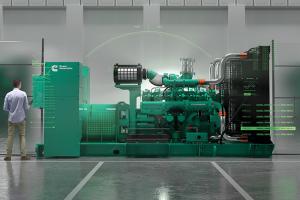Furniture breaks away from institutional design
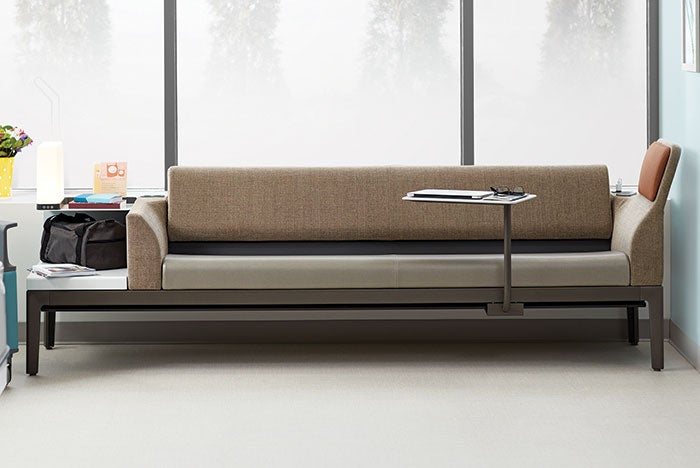
Steelcase Health furnishings are designed to support family members in health care environments.
Ergonomics, strength, cleanability, family-friendly features and modular designs are key elements of the latest hospital furniture. Highly configurable designs that accommodate a variety of health care spaces represent another trend, along with universal design solutions that meet the needs of all users.
Among the challenges to specifying furniture for hospital settings is the need to design highly durable, multifunctional furniture that works across a broad spectrum of users. The 24/7 health care environment, paired with a need for elevated cleanability, poses another challenge.
“Privacy also must be considered when planning health care environments,” says Deborah Breunig, vice president of sales and marketing for the health care market, KI Furniture, Green Bay, Wis. “It is possible to achieve a level of privacy and openness by using glass architectural wall solutions or mobile furniture solutions that allow hospitals to cater to each patient’s unique needs.”
Four furniture trends
A closer look at some of these features demonstrates how furniture manufacturers are meeting the needs of the health care environment.
Ergonomics
The latest ergonomics innovations for furniture focus on both patients and caregivers. These innovations facilitate movement for all parties, help to improve productivity and reduce the likelihood of injuries.
You may also like |
| Health care furniture gets technology boost |
| Flexible casework helps health care facilities adapt |
| Modular wall systems improve flexibility, infection prevention and privacy |
|
|
There are certain commonalities when it comes to patient ergonomics, but no two patients are alike, says Angel Ness, health care contract sales manager, Champion Manufacturing Inc., Elkhart, Ind. An individual patient’s height, weight, strength, dexterity and other factors determine his or her unique ergonomics. “We design for the middle of the potential patient population and then offer a wide range of features, options and accessories that allow caregivers to customize solutions for their unique patient populations.
“During the design phase, you must consider what you can put within the reach of a patient’s fingertips to facilitate their safety, support, comfort and empowerment,” Ness adds. ”Champion offers heat, massage, TV mounts, tablet holders and a variety of cushions to empower patients and enhance comfort.”
From an ergonomics perspective, the physical well-being of health care workers often has been overlooked in the past, according to Tim Straker, vice president, marketing/global customer experience, Herman Miller Inc., Zeeland, Mich. On a positive note, he sees more hospitals investing in high-performing ergonomic seating, as well as an increased adoption of height-adjustable surfaces, and a wider variety of work solutions and postures. These solutions help to optimize ergonomics for specific work modes and activities.
Bariatrics
The days of defining furniture as bariatric are coming to an end, according to manufacturers that supply the nation’s health care facilities. Instead, the focus is on designing solutions for the needs of all, rather than a select group, which is a more inclusive and respectful approach to design as it provides equality across the population. And with an estimated one-third of the U.S. population considered to be obese, manufacturers still offer specially designed seating solutions that meet the needs of this patient population.
“Safety is the No. 1 consideration when designing bariatric solutions,” Breunig says. “Our bariatric seating safely accommodates people who weigh up to 750 pounds. It is important to address safety in ingress and egress along with structural integrity that visually assures the user.”
KI Furniture also addresses the issue of dignity and, thus, designs solutions that integrate with other furniture collections. “Universal design is the ultimate consideration: solutions that meet the needs of all users, not segregating users based on size.” For example, KI Furniture’s Arissa collection accommodates people weighing up to 750 pounds, yet can be used comfortably by the general population.
Cleanability
Hospital furniture is subject to much wear and tear, which includes stains, so cleanability is an important issue. In fact, with cleaning protocols becoming more stringent and standardized, it is now more challenging to create environments that feel less institutional and austere but meet a high bar of cleanability. “Many of the innovations in product design that improve cleanability (for example, wipeouts) have become table stakes, so the next trends lie in innovative textiles and finishes that can be both cleanable and naturally textural and beautiful,” Straker says.
Cleanability and infection control are two of the most pressing issues to consider for furniture design and durability, according to Nathan Chandler, director of new product category, Steelcase Health, Grand Rapids, Mich. “While the physical design of a product to facilitate effective cleaning is reasonably accomplished, the cleaning products and chemicals themselves are an area of contention,” Chandler explains. “With more interest in environmental sustainability, there is growing tension between the use of chemicals and cleaning protocols that do not align sustainability objectives with the long-term durability of many fabrics and product finishes. This continues to be an area for broader discussion and education.”
Family-friendly designs
More hospital furniture today features family-friendly designs that help patients and their families to feel comfortable, which is especially important when overnight stays are required. In fact, the health care industry is looking to other industries, such as hospitality, as an inspiration for the design of spaces and products, and for insight into improving the customer experience.
One example is the Cama Family Chaise Sleeper, designed for comfortable family engagement during a loved one’s stay in the hospital. The newest piece in the Healing Touch Collection by IOA Inc., Thomasville, N.C., it cradles family members in a comfortable nook that converts from a chaise by day to a sleeper by night.
It allows multiple seating positions — both side-by-side sitting and lounging. The height and angle of the back creates a supportive huglike sitting position, while the angle of the chaise position promotes eye contact with the bedridden patient. Via a front pull release, the seat deck slides out to the needed Chaise Sleeper depth, says Rosalyn Cama, president, Cama Inc., New Haven, Conn. “Families are encouraged to engage in active communications with the patient as well as with other visiting family members. Because of the variety of comfortable positions possible, families also can maintain daily activities such as working or reading.”
Multiuse solutions
Among the newest hospital furniture that incorporates ergonomics, cleanability, family-friendly features and modular designs is the Champion Comfort-4 ECO, a multipurpose chair that fits well into various hospital settings. It helps to facilitate the work of physicians and medical staff by providing a single platform for patient examination, diagnosis, treatment and observation, delivering care in a cost-effective manner.
Being able to provide a recliner that can be used in different departments within a health care facility is important, Ness adds, because multiuse furniture products offer facilities managers flexibility and keep capital equipment costs down.
Herman Miller recently introduced Intent, an exam room technology solution that combines a wall-based media tile and height-adjustable mobile table. It facilitates provider-to-patient and guest interaction even as technologies and devices change over time — or as they change from provider to provider. Nemschoff, a subsidiary brand of Herman Miller, has unveiled Repose, a multipostural sleep solution. It easily transitions from sitting to lounging to sleeping, thanks to a mechanism-free design, so multiple guests can work, converse or rest while remaining at the patient’s side.
Steelcase Health offers the Surround Collection, furnishings designed to support family members in health care environments. It has the flexibility to serve as a sleep surface or sofa, and to support eating, working and socialization activities, offering family members a designated space to support the care of their loved ones, relax in comfort and communicate effectively with clinicians.
“Its design allows for more than 120 configurations, and lengths from 44 to 104.5 inches that accommodate a variety of health care spaces,” Chandler says. “One-seat, two-seat and three-seat sleeper applications can be used in patient rooms and in lounge and waiting areas.”
The Caterina Guest collection from Kwalu, Atlanta, is designed for hospital settings such as waiting rooms, emergency departments and patient rooms, according to Sylvia Nash, vice president of health care sales. The chair frames, which are health care chemical-proof, look like wood, but are actually made from a high-impact-resistant polymer, which means they don’t have the drawbacks of wood. The chairs are available in slat-back and fully upholstered-back designs.
The Foster Collection from Allseating Corp., Mississauga, Ontario, addresses the many challenges the health care field faces today in one comprehensive collection, according to Michelle Crill, Midwest region health care program director. It includes patient, guest and lounge seating that can be arranged in multiple and tandem configurations, plus benches and ottomans. Complementary tables round out the line. “The Foster Collection keeps the patient, family and caregiver top of mind, while making it easy for the facilities team to keep furniture looking fresh,” Crill says.
Smaller off-site facilities such as specialty clinics pose some unique challenges to vendors. However, they are embracing this market by working on a smaller scale.
“The key challenges have to do with the size and nature of these smaller facilities,” says Straker. “Because space is at a premium, we have to help our customers make more out of less.
“We also help them to think at a more macro scale about not just one or two facilities, but a network of facilities in which they can manage a portfolio of products. These smaller facilities are often leased and change-over is frequent,” Straker continues. “The question is ‘How can we help customers think through Year 1, Year 2, Year 3, and across their real estate portfolio?’”
Crill says that Allseating works to ensure that purchasers for these off-site facilities — who often have less purchasing experience and smaller budgets — make the right choices for their setting. “Buyers at these clinics don’t purchase seating on a daily basis and their budgets may be lower than in the acute care realm,” she says. “Our team collaborates with specifiers to lay out options.”
Drivers for change
The health care and design fields are both moving toward increased emphasis on sustainability.
Technology also is going to be a great driver of change. For example, vendors predict that more hospital furniture products will include power sources.
These trends align with health care’s overall focus of delivering excellent patient experiences, while optimizing caregiver workflow and improving safety.
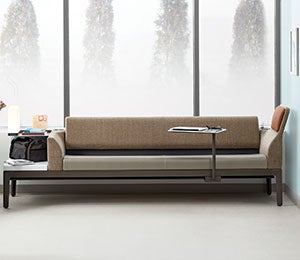
Family affair
The Surround Collection of furnishings has the flexibility to serve as a sleep surface or sofa to support the varied needs of family members. Steelcase Health
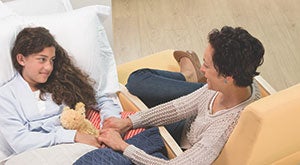
Well-positioned
The Cama Bed Chair is a height-adjustable, three-position recliner that supports interactions at the bedside. IOA Inc.
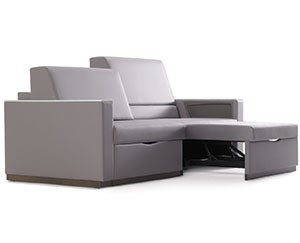
Open seating
Repose is a multipostural sleep solution that transitions from sitting to lounging to sleeping easily and quietly, thanks to a mechanism-free design. Nemschoff
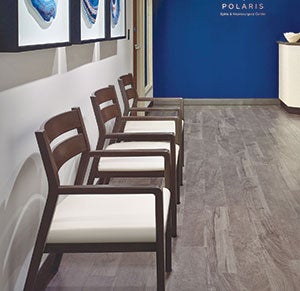
Ease of use
The Caterina Guest Slat-Back chair features clean lines, a spacious removable seat, an angled back and angled, contemporary arms to facilitate ingress and egress. Kwalu
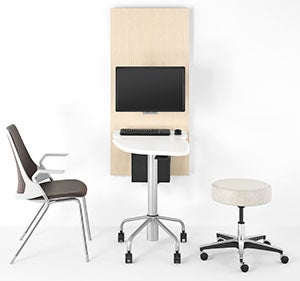
Better together
Intent combines an all-purpose table with an integrated wall system to help caregivers in exam rooms use all sorts of technology. Herman Miller
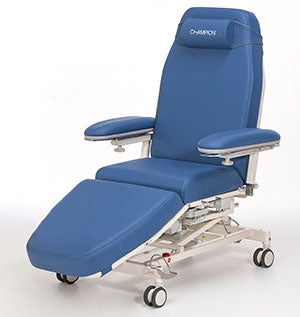
Up and down
The Comfort-4 ECO is fully powered with vertical height adjustment, allowing physicians and staff to facilitate their care. Champion
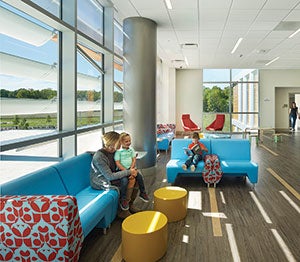
Personal fit
Nemours Children’s Health System uses brightly colored alcoves and KI’s MyWay lounge seating throughout its facility to create whimsical, welcoming environments for patients, family and staff. KI Furniture
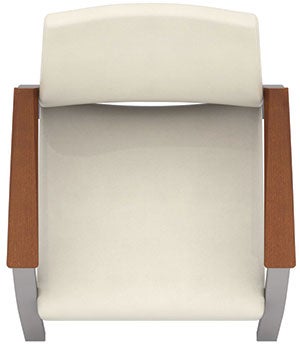
Clean streak
The Foster Collection has open-arm seating options for times when a deeper cleanout is necessary. Allseating


